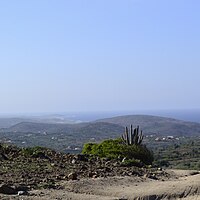
Photo from wikipedia
Soil and air pollution caused by heavy metals and limestone dust are prevalent in urban environments and they are an alarming threat to the environment and humans. This study was… Click to show full abstract
Soil and air pollution caused by heavy metals and limestone dust are prevalent in urban environments and they are an alarming threat to the environment and humans. This study was designed to investigate the changes in morphological and physiological traits of three urban tree species seedlings (Bombax ceiba, Conocarpus lancifolius, and Eucalyptus camaldulensis) under the individual as well as synergetic effects of heavy metal lead (Pb) and limestone dust toxicities. The tree species were grown under controlled environmental conditions with nine treatments consisting of three levels of dust (0, 10, and 20 g) and three levels of Pb contaminated water irrigation (0, 5, and 10 mg L−1). The results depicted that the growth was maximum in T1 and minimum in T9 for all selected tree species. B. ceiba performed better under the same levels of Pb and limestone dust pollution as compared with the other two tree species. The B. ceiba tree species proved to be the most tolerant to Pb and limestone pollution by efficiently demolishing oxidative bursts by triggering SOD, POD, CAT, and proline contents under different levels of lead and dust pollution. The photosynthetic rate, stomatal conductance, evapotranspiration rate, and transpiration rate were negatively influenced in all three tree species in response to different levels of lead and dust applications. The photosynthetic rate was 1.7%, 3.1%, 7.0%, 11.03%, 16.2%, 23.8%, 24.8%, and 30.7%, and the stomatal conductance was 5%, 10.5%, 23.5%, 40%, 50.01%, 61.5%, 75%, and 90.9%, greater in T2, T3, T4, T5, T6, T7, T8, and T9 plants of B. ceiba, respectively, as compared to T1. Based on the findings, among these three tree species, B. ceiba is strongly recommended for planting in heavy metal and limestone dust-polluted areas followed by E. camaldulensis and C. lancifolius due to their better performance and efficient dust and heavy metal-scavenging capability. Graphical Abstract
Journal Title: Frontiers in Plant Science
Year Published: 2023
Link to full text (if available)
Share on Social Media: Sign Up to like & get
recommendations!